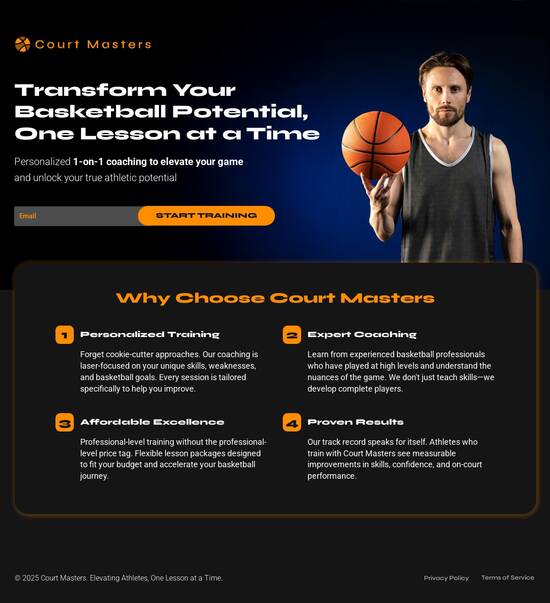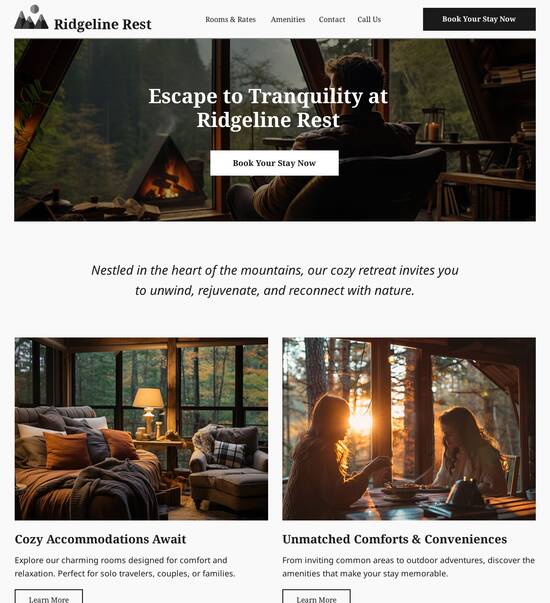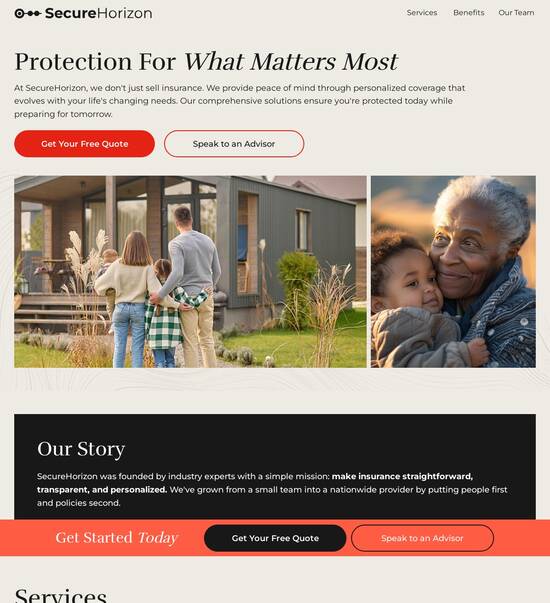
HTML page template with interactive emergency alert bar
Explore Similar TemplatesAbout template
Use HTML page templates with interactive emergency alert bar and make your communications easy and transparent. Try our solution today.
Recommended templates

Easy to build without coding
With the intuitive drag-and-drop builder, anyone on your team can create high-converting pages without any knowledge of code or design. Make enhancements to your landing page with custom widgets using Javascript, HTML/CSS, or third-party scripts.

Multiple layouts for any industry and goal
Select from 500+ landing page layouts built to boost conversions across industry-specific scenarios. Customize them by adjusting fonts, adding images, and generating on-brand content with the AI assistant. Quickly scale with Instablocks® and Global Blocks that you can save, reuse, and update globally.

Loads fast and looks polished on any device
Every template is responsive, which means they present professionally on any device and load blazingly fast with our Thor Render Engine. You can also power them up with Google AMP technology to deliver an unparalleled mobile experience and drive higher conversions.

Robust analytics & experimentation
Get real-time updates and reporting across all your devices, showing the number of visitors, conversions, cost-per-visitor, and cost-per-lead. Launch AI-powered experiments, run A/B tests, and use heatmaps to analyze user behavior, then optimize your landing page to maximize conversions.







Easy to build without coding
With the intuitive drag-and-drop builder, anyone on your team can create high-converting pages without any knowledge of code or design. Make enhancements to your landing page with custom widgets using Javascript, HTML/CSS, or third-party scripts.
Multiple layouts for any industry and goal
Select from 500+ landing page layouts built to boost conversions across industry-specific scenarios. Customize them by adjusting fonts, adding images, and generating on-brand content with the AI assistant. Quickly scale with Instablocks® and Global Blocks that you can save, reuse, and update globally.
Loads fast and looks polished on any device
Every template is responsive, which means they present professionally on any device and load blazingly fast with our Thor Render Engine.
Robust analytics & experimentation
Get real-time updates and reporting across all your devices, showing the number of visitors, conversions, cost-per-visitor, and cost-per-lead. Launch AI-powered experiments, run A/B tests, and use heatmaps to analyze user behavior, then optimize your landing page to maximize conversions.
All the features you need to build yellow warning sign html code
Explore more featuresLearn how to build pre alert email sample
FAQs
Leading the way in building high-performing landing pages





Create a high-converting HTML page template with an interactive emergency alert bar using Instapage
Designing an effective HTML page template with an interactive emergency alert bar on Instapage not only grabs your audience's attention but also significantly boosts conversion rates. With the right tools at your disposal, you can enhance your marketing strategy in measurable ways.
Understanding the need for an emergency alert bar
An emergency alert bar is vital for conveying urgent messages to your visitors. It can be used for important announcements, promotions, or critical updates. This feature ensures that essential information isn't overlooked, thus enhancing engagement.
- Grabs attention instantly: An interactive alert bar captures attention due to its visibility at the top of the page.
- Delivers urgent information: Instantly communicate critical updates or promotions to your audience.
- Improves user experience: Helps guide users towards necessary actions, enhancing the overall site usability.
Step 1: Choose the right Instapage template
Start by selecting a template that aligns with your campaign goals. Instapage offers over 100 conversion-focused templates to choose from, allowing you to customize immediately.
- Select a template with a clear layout to emphasize the emergency alert bar.
- Ensure it has the flexibility to add interactive elements without coding knowledge.
- Check that it integrates well with your existing marketing tools for optimal performance.
Step 2: Customize your alert bar
After selecting your template, it’s time to enhance it with a personalized alert bar. Use a combination of colors and text to create urgency and importance.
- Choose contrasting colors for the alert bar to make it stand out.
- Add dynamic text replacement to personalize messages based on audience segments.
- Incorporate a clear call-to-action within the alert to guide users towards specific actions.
Step 3: Test and optimize your landing page
The final step involves testing the effectiveness of your HTML page template. Leverage Instapage's built-in A/B testing and heat maps to monitor user engagement and optimize conversions.
By analyzing the data, you can make informed adjustments that'll improve user interaction and satisfaction ultimately.
Ready to start creating compelling landing pages? Explore Instapage’s features today and elevate your campaigns with an HTML page template that includes an interactive emergency alert bar.
People also ask about HTML page template with interactive emergency alert bar
HTML page template with interactive emergency alert bar
Understanding the interactive emergency alert bar: a modern necessity
An interactive emergency alert bar plays a vital role in web design by providing real-time notifications during critical situations. It is designed to alter user engagement during emergencies, ensuring that important information is effectively communicated. Unlike static alert bars that simply display information, interactive alert bars encourage user interaction and response, which can be crucial during urgent scenarios.
Integrating an emergency alert bar into your website enhances user safety and awareness, especially in sectors like healthcare, finance, and government. For instance, users may receive alerts about natural disasters, health warnings, or critical service announcements. The use of interactive elements can significantly influence user behavior, prompting them to take necessary precautions or evacuate in critical situations.
Core features of the HTML page template
An effective HTML page template with an interactive emergency alert bar includes several core features that enhance its usability and appeal. Firstly, customizable design options are crucial; users should be able to select from a range of templates that offer various colors, fonts, and styles. CSS plays a paramount role in achieving a tailored aesthetic that matches the overall website branding while ensuring optimal visibility of alerts.
In addition, responsive design is necessary to ensure that the alert bar is visible across various devices, whether on desktop, tablet, or mobile. Testing compatibility with different screen sizes helps maintain the alert bar's functionality and visibility. Moreover, dynamic content delivery is a game-changer—real-time updates and alerts can be integrated with external APIs, delivering live data that is crucial during emergencies.
Setting up your interactive emergency alert bar
Setting up your HTML page template to include an interactive emergency alert bar involves a straightforward procedure. Start by developing the basic HTML structure that incorporates the alert bar in a prominent position on the webpage. This typically means placing it at the top of the page, where it will grab the user’s attention. JavaScript is utilized to enhance interactivity, allowing for user-triggered actions such as acknowledging or dismissing alerts, ultimately providing a better user experience.
CSS styling techniques are equally essential in making sure that the alert bar is easily noticeable. Key considerations include using bright colors like red or yellow, which signal urgency, and bold fonts that stand out. Examples of effective color choices are important; for instance, a combination of red for alerts and white text can improve readability. Additionally, animations—like a gentle slide or fade-in effect—can draw attention without being overly distracting.
Create a basic HTML structure with a div for the alert bar.
Incorporate JavaScript for interactive elements.
Style the alert bar using CSS for visibility.
Enhancing user experience with the alert bar
Engaging internet users effectively during emergencies requires a nuanced approach. The psychological impact of alerts on user behavior is significant; a well-designed alert can prompt immediate action from users. This means balancing the urgency of the message with ongoing user engagement. For instance, while a loud alert might grab attention, a subtle animation can create a sense of urgency without alarming the user.
Professionally applying alert bars within web design means taking cues from successful case studies across different industries. For example, educational institutions use alert bars to disseminate information on campus emergencies, while healthcare organizations might use them for public health alerts. By adapting the design and content of alert bars to fit the context—whether by including local emergency contacts or specific event details—websites can maximize their effectiveness.
Testing and optimizing your alert bar
Testing and optimizing your alert bar is crucial for ensuring it meets user needs and performance goals. Employing tools and techniques for testing alerts can significantly enhance user engagement. Analytics can provide insights into how often users view the alert bar, their interactions with it, and whether they act on the alerts. By employing A/B testing, different alert styles or placements can be assessed to determine the most effective layout.
Additionally, routine evaluations are necessary after major incidents. For example, if a natural disaster occurs, reviewing the alert bar’s engagement metrics can guide necessary changes. Gathering user feedback is another avenue for continuous improvement, allowing adjustments to be made based on real user experiences and needs. Combining these methods fosters an iterative design process that enhances the alert system’s effectiveness.
Tailoring the alert bar for different audiences
Understanding that different audiences have varied needs is essential in designing an effective alert bar. Beginners can benefit from simplified templates that guide ease of use, allowing them to quickly implement a basic alert system on their websites. Moreover, providing comprehensive tutorials specifically designed for novice users can enhance their confidence and encourage more effective implementations.
On the other hand, professionals may require advanced options that allow for more complex setups, such as custom JavaScript or advanced CSS animations. Furthermore, enabling multi-language support helps cater to diverse user bases, ensuring that language barriers do not hinder access to crucial information. Lastly, selecting components based on user needs—such as weather alerts, health warnings, or local safety notices—adds a level of personalization that can significantly improve user engagement.
Real-world impact: success stories and statistics
The real-world impact of effective emergency alert bars is unmistakable. Case examples from various industries showcase successful implementations and how they contributed to a higher level of preparedness among users. For instance, in the financial sector, institutions implementing timely financial alerts have witnessed reduced panic during market volatility, leading to better-informed clients.
Quantitative results further emphasize this success; organizations that effectively communicate alerts typically report improved engagement rates and user responses. Such measures not only enhance user trust but also promote community safety and readiness. Moreover, millions of internet users have benefited from these systems, underlining the broader impact that well-designed alert mechanisms can have on public safety.
Broadening your skills: learning resources
Continuous learning is key to mastering the implementation of interactive emergency alert bars. Various resources are available for all skill levels; beginners may start with basic HTML/CSS tutorials that focus on web design fundamentals, while more advanced courses can explore JavaScript programming and custom styling techniques.
In addition, complementing the alert bar feature with the right tools can enhance overall efficacy. Best practices recommend using analytical tools for monitoring user engagement and response, thus streamlining your ability to adjust and optimize alerts. Efficient workflows that incorporate testing, feedback, and adaptation are essential to improve user engagement consistently.
Final thoughts: the future of interactive alerts
As technology continues to evolve, emerging trends in web design will shape the future of interactive alert systems. Predictions suggest a growing necessity for more sophisticated communication channels that account for the varied needs of diverse user populations. This may include artificial intelligence-driven alerts that personalize messages according to user behavior and preferences.
Ultimately, empowering people through intelligent design solutions can enhance community safety. By leveraging technology to create responsive digital environments, businesses can foster trust and loyalty among their users. As we move forward, the integration of proactive alert mechanisms will be crucial in maintaining user engagement during crucial moments, proving that technology plays a pivotal role in safeguarding communities.
Ready to skyrocket conversions?
Supercharge your ad campaigns with high-performing landing pages
Get started














